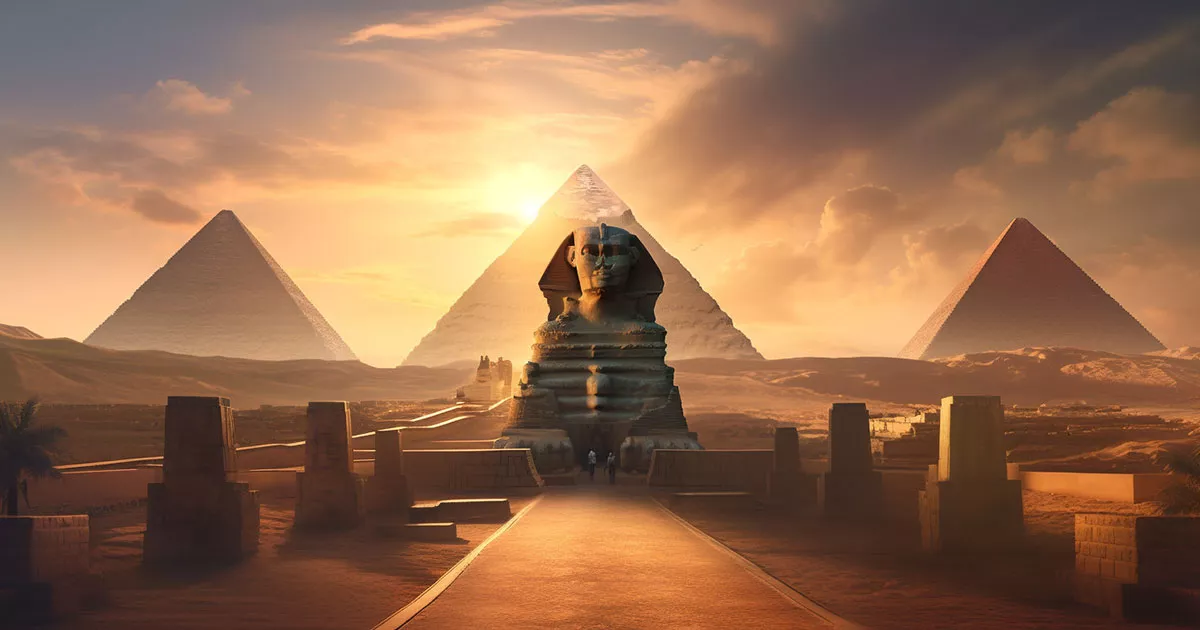

The Great Sphinx of Giza in Egypt, typically known as the Sphinx, is an iconic limestone statue located near the Great Pyramids of Giza in Egypt. With the body of a lion and the head of a human, it is a unique architectural marvel that has captured the imaginations of generations of archaeologists, historians, and tourists alike. Despite its fame, many mysteries continue to surround the Sphinx, not least of which is its actual age.
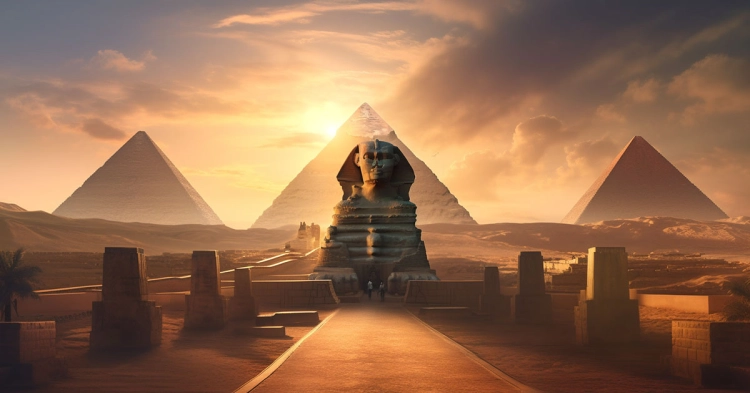
The prevailing view among historians and Egyptologists is that the Great Sphinx of Giza Height was built during the reign of the Pharaoh Khafre, a ruler during Egypt’s Fourth Dynasty (c. 2575–c. 2465 BCE). Pharaoh Khafre, also known as Chefren, was the son of Khufu (Cheops), who is credited with building the Great Pyramid of Giza.
Khafre’s pyramid, the second largest of the Giza Pyramids, and his associated temples share the plateau with the Sphinx, which is situated to the east of the pyramid. The Great Sphinx of Giza’s close proximity to these structures and the architectural and artistic style of the surrounding complex, particularly the Sphinx Temple and the Valley Temple of Khafre, which bear likeness in design, lead most experts to ascribe its construction to Khafre’s time.
The Sphinx’s human head also bears a semblance to Khafre, as observed from statues and representations of the pharaoh, though this remains a matter of debate due to weathering and certain damage (such as the loss of the nose) over the millennia.
Archaeologists also draw conclusions about the Sphinx’s age based on stylistic and architectural analysis. The limestone blocks used to construct the nearby Sphinx Temple are believed to have been quarried from the Sphinx enclosure, suggesting simultaneous construction. The style of stone masonry and the layout of these temples are consistent with the architectural norms of the Fourth Dynasty.
The design and craftsmanship of the Sphinx are also consistent with other artifacts from the Old Kingdom period. During this era, monumental statues often portrayed the pharaoh as a means to signify their divine status, power, and control over the chaos of the natural world. The Great Sphinx of Giza, combining the king’s head with the body of a lion, symbolizes the pharaoh’s strength, wisdom, and authority, aligning well with Old Kingdom iconography.
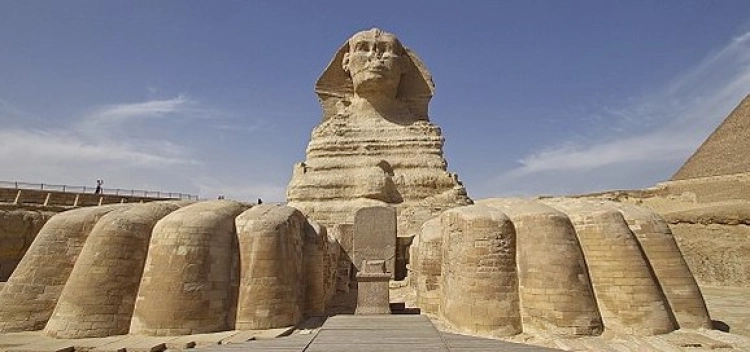
Another piece of historical evidence is the granite stela placed between the paws of the Sphinx by Pharaoh Thutmosis IV in the New Kingdom (1400-1390 BCE), over a millennium after Khafre’s reign. This stela, known as the Dream Stele, doesn’t directly provide the Great Sphinx of Giza’s age, but it recounts a dream where the Sphinx, identifying itself as the god Horemakhet, promises Thutmosis the throne of Egypt in return for clearing away the sand covering its body.
While this stela doesn’t offer a direct date, it shows that by Thutmosis’s time, the Sphinx was already an ancient and significant monument, giving credence to the belief that it was constructed during the Old Kingdom, aligning with Khafre’s reign.
Thus, through a combination of historical, architectural, and stylistic analysis, most Egyptologists date the construction of the Sphinx to around 2500 BCE, making it over 4,500 years old. However, it’s important to remember that these are educated deductions, not definitively proven facts. As such, the age of the Sphinx remains a topic of ongoing research and debate.
While the widely accepted theory posits that the Great Sphinx of Giza was built around 2500 BCE, during the reign of Pharaoh Khafre, several lines of evidence have been presented that challenge this dating and suggest a much older origin for this enigmatic monument.
One of the main arguments for an older Sphinx comes from geology. Certain features of the Great Sphinx of Giza, particularly on its body and the surrounding enclosure walls, show signs of erosion that some researchers argue could only have been caused by prolonged exposure to heavy rainfall.
This hypothesis was most prominently proposed by John Anthony West, an independent Egyptologist, and later further developed by Dr. Robert Schoch, a geologist from Boston University. They argue that the patterns and features of erosion on the Sphinx, including deep vertical weathering and rounded corners and edges, resemble those caused by water runoff during periods of heavy rainfall and flooding.
The climatological history of the Giza Plateau is crucial in this regard. The Sahara Desert region, where the Sphinx is located, has had an arid climate for the last 5000 years. However, before this period, it experienced significant rainfall. Thus, if the water erosion hypothesis is correct, the Sphinx’s construction would predate the arid conditions, suggesting that it might be older than 7000 years.
Another line of evidence suggesting an older Sphinx comes from the field of archaeoastronomy. This discipline studies how ancient cultures might have incorporated astronomical observations into their architecture and mythology.
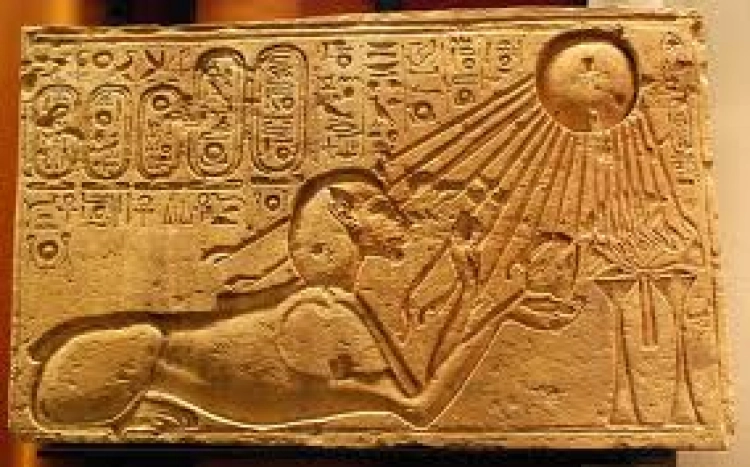
In this context, some researchers, most notably author and alternative history theorist Graham Hancock and engineer Robert Bauval, have proposed that the Great Sphinx of Giza is aligned with the constellation of Leo as it would have appeared in 10,500 BCE.
The Great Sphinx of Giza is positioned to face directly eastward, and at the spring equinox, it would have seen the sun rise in conjunction with the constellation Leo during this period. Given the lion-bodied design of the Sphinx, some suggest this could have been intentional, indicating that the Sphinx might have been constructed as an astronomical marker around 10,500 BCE, making it significantly older than conventionally believed.
There are several other features and artifacts in and around the Great Sphinx of Giza that don’t easily fit into the conventional timeline. For instance, there is the so-called “Inventory Stela” (although widely regarded as a much later historical forgery) which purports to date from the time of Khufu, Khafre’s predecessor, and claims that the Sphinx was already standing at Khufu’s time.
While these theories are intriguing, it’s important to remember that they remain highly controversial and are not widely accepted by mainstream historians and archaeologists. Critics argue that the water erosion could have been caused by other factors, such as occasional heavy rainfall during the Old Kingdom or the presence of water in the sand covering the Sphinx.
The Leo alignment theory is also questioned as the constellation’s shape has varied over time due to the precession of the equinoxes, and the lion symbolism associated with Leo wasn’t established until much later in Egyptian history.
Despite the critiques, these alternative theories highlight the complexities involved in dating an ancient and weathered monument like the Great Sphinx of Giza, and the potential insights to be gained from interdisciplinary research. The debate over the Sphinx’s age continues to fuel ongoing research and exploration, testament to the enduring allure of this ancient monument.
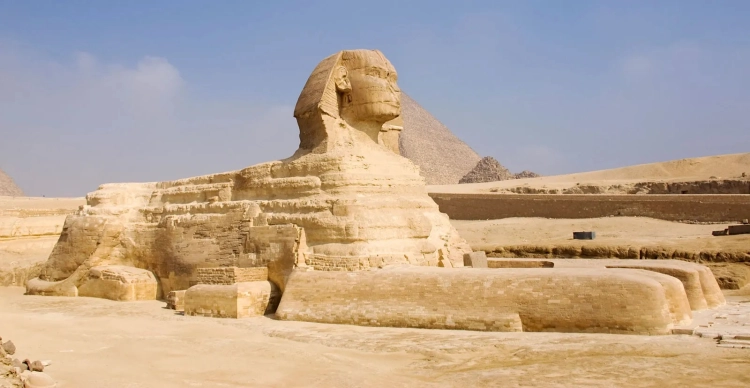
The possibility of the Great Sphinx of Giza being significantly older than currently believed holds potentially transformative implications for our understanding of ancient history and civilization. If the alternative theories suggesting a pre-Old Kingdom origin for the Sphinx were to be substantiated, it would necessitate a radical reevaluation of both Egyptian and global prehistory.
The first and most immediate implication of an older Sphinx would be the reevaluation of the timeline of ancient Egyptian civilization. Egyptologists currently believe that the era of monumental construction in Egypt began with the start of the Dynastic period, around 3100 BCE. However, if the Great Sphinx of Giza were shown to be significantly older, it would imply the existence of a sophisticated, monument-building civilization in Egypt well before the onset of the Dynastic period.
An older Sphinx could also lead historians to hypothesize about the existence of a “lost civilization” – an advanced society that was capable of monumental architecture and that existed before the conventional dawn of civilization, around 4000 to 3000 BCE. This notion challenges the traditional linear progression of human development and suggests that human history may be far more complex than currently believed.
An older Sphinx could also suggest connections with other ancient, unexplained archaeological sites around the world. Some researchers who support the older Sphinx theory also point to sites such as Göbekli Tepe in Turkey and the megalithic structures of Malta as potential evidence of a previously unknown, globally extensive civilization existing during the end of the last Ice Age.
Göbekli Tepe, a site dated to around 9600 BCE, predates Stonehenge by more than 6000 years and is thought to be the oldest known temple complex. Its existence has already forced a rethinking of the timeline of architectural development. If the Great Sphinx of Giza were to be dated back to a similar time period, these seemingly disparate sites could potentially be linked, suggesting a widespread culture or network of cultures with advanced architectural and astronomical knowledge.
An older Sphinx might also necessitate rethinking our understanding of historical climate change and human responses. If the Sphinx was indeed weathered by significant rainfall, its construction and early history would have taken place during a period of climatic transition from the wetter conditions of the African Humid Period to the current arid conditions of the Sahara Desert.
This could provide valuable insights into how early human societies responded to climate change, offering potentially useful lessons for our current global situation.
These far-reaching implications make the age of the Great Sphinx of Giza a subject of intense debate. While the idea of an older Sphinx and a lost prehistoric civilization is tantalizing to some, many researchers caution against drawing sweeping conclusions from ambiguous evidence.
The mainstream academic community generally views these theories with skepticism, pointing out that they often rely on controversial interpretations of evidence and a selective reading of archaeological and historical data. Critics also note the lack of direct archaeological evidence for a lost civilization of the proposed antiquity and sophistication.
Nevertheless, as long as questions about the Sphinx’s age and origins persist, the allure of these implications will continue to spark interest and fuel ongoing research into this enduring enigma of the ancient world.
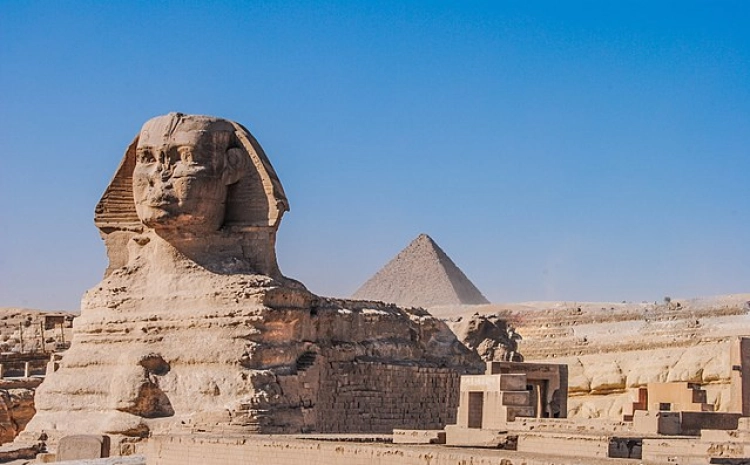
Determining the age of the Great Sphinx of Giza, or any ancient monument for that matter, is a challenging endeavor. Archaeologists, geologists, and historians face a variety of obstacles when trying to date the Great Sphinx of Giza, primarily due to the lack of direct evidence, weathering effects, and interpretive ambiguities.
One of the main challenges in determining the Sphinx’s age is the lack of direct historical records. Unlike some other Egyptian monuments, there are no known inscriptions that clearly state when the Sphinx was built or by whom. The Dream Stele of Thutmosis IV, located between the Great Sphinx of Giza’s paws, refers to the monument as already existing during his reign, but it does not provide a precise date of its creation.
Similarly, the “Inventory Stela”, which claims that the Great Sphinx of Giza was already present during the reign of Khufu, Khafre’s predecessor, is widely regarded as a later historical forgery, thus undermining its credibility as a source for dating the monument.
The Great Sphinx of Giza has been exposed to harsh weather conditions for thousands of years, resulting in significant erosion and deterioration. This weathering not only makes it difficult to analyze the monument’s original features but also complicates efforts to evaluate different theories about its age, such as the water erosion hypothesis.
What’s more, the Great Sphinx of Giza has undergone several restorations, both in ancient times and more recently. These efforts, while necessary for preservation, can obscure the original state of the monument and make it more difficult to draw conclusions about its age.
When dealing with archaeological and geological evidence, there is often a degree of interpretative ambiguity. For instance, although some researchers interpret the patterns of erosion on the Sphinx as indicative of water damage from prolonged rainfall, others argue that these patterns could have been caused by other factors, such as wind erosion, ground water, or even the unique composition of the limestone from which the Great Sphinx of Giza was carved.
Similarly, the proposed Leo alignment of the Great Sphinx of Giza is subject to uncertainties about the precise configuration of the constellation in ancient times, as well as the cultural significance of Leo to the civilization that built the Sphinx.
Finally, if the Great Sphinx of Giza were indeed thousands of years older than currently believed, the absence of other comparable archaeological structures from the same period presents a significant challenge. An advanced civilization capable of constructing something like the Sphinx would presumably have left other evidence of its existence, yet no such evidence has been conclusively identified.
This absence does not definitively disprove the possibility of an older Sphinx, but it adds an extra layer of difficulty to the already complex task of dating this ancient monument.
Despite these challenges, researchers continue their efforts to determine the age of the Great Sphinx of Giza, utilizing an array of methodologies from various disciplines, including archaeology, geology, climatology, and even astronomy. While we may never arrive at a definitive answer, the quest for the Sphinx’s origins remains a testament to human curiosity and our enduring fascination with the mysteries of the past.
Despite centuries of study and countless theories put forth, the age of the Great Sphinx of Giza remains one of the most enduring mysteries in the field of archaeology. This ancient monument continues to captivate scholars and laypeople alike, drawing us into its enigmatic gaze and inviting us to delve into the depths of its history.
As new technologies and methodologies are developed, the Sphinx increasingly finds itself in the interdisciplinary spotlight. Archaeologists, historians, geologists, climatologists, and astronomers are all working to uncover the monument’s secrets. Each discipline brings its unique perspective and tools, contributing to a more nuanced understanding of the Sphinx.
Advanced imaging techniques, for example, have allowed us to “see” beneath the Sphinx, revealing hidden chambers that may hold clues to its origins. Similarly, sophisticated climate modeling has shed new light on the environmental conditions that shaped the Sphinx and its surroundings.
By combining these different approaches, researchers can construct a more comprehensive picture of the Sphinx’s past, moving us closer to unravelling its mysteries.
What we know about the Sphinx today is largely dependent on what has been found so far. The discovery of new archaeological sites, artifacts, or historical texts could drastically change our understanding of this ancient monument.
In Egypt and around the world, archaeological discoveries continue to revise our understanding of human history. A significant find in the future could provide the missing piece of the puzzle that unlocks the true age of the Sphinx.
Meanwhile, the Sphinx remains a touchstone for debates about our understanding of the past. Theories about its age reflect larger discussions about the origins of civilization, the progression of human development, and the potential for lost or forgotten epochs in our history.
The controversy surrounding the Sphinx’s age underscores the importance of challenging established narratives and remaining open to new interpretations. Whether or not one agrees with the alternative theories, they serve to broaden our perspective and remind us that history is a dynamic, evolving field.
Ultimately, the mystery of the Sphinx’s age is more than just a question of dates. It is a gateway into the past, inviting us to explore the origins of one of the world’s earliest civilizations and, by extension, the broader story of humanity.
Regardless of when it was built, the Sphinx stands as a testament to human ingenuity and our enduring desire to leave a mark on the world. As we continue to grapple with its age, we not only come closer to understanding the Sphinx itself but also gain deeper insights into our collective past and our place within the grand tapestry of history.
The Great Sphinx of Giza is traditionally believed to have been built around 2500 BCE during the reign of the Pharaoh Khafre, who was the ruler of Egypt from about 2520 to 2494 BCE during the Fourth Dynasty of the Old Kingdom. Khafre is also credited with building the second largest of the Great Pyramids at the Giza complex, which is situated near the Sphinx.
The attribution to Khafre is based on several pieces of evidence. The Sphinx is located in the complex of structures that includes the Pyramid of Khafre, suggesting a connection to his reign. Additionally, the architectural style and the manner in which the Sphinx was carved directly from the bedrock, with certain parts possibly built up with stone blocks, are consistent with construction methods during the Old Kingdom when Khafre ruled.
Based on comparisons with other monumental construction projects in ancient Egypt and considering the tools and labor likely available at the time, some Egyptologists speculate that it could have taken anywhere from several years to possibly a few decades to fully carve the Sphinx. However, without concrete historical data, these remain estimations. The true timeline of the Sphinx’s construction remains one of its many enduring mysteries.
The face of the Great Sphinx is traditionally believed to represent the Pharaoh Khafre, who reigned during Egypt’s Fourth Dynasty and is also credited with constructing the second-largest pyramid at the Giza complex. This belief is based on the Sphinx’s location on the Giza Plateau, near Khafre’s pyramid, and similarities between the face of the Sphinx and known statues of Khafre.
The Great Sphinx of Giza is famously missing its nose, but the exact circumstances of its loss remain uncertain. The nose was still intact in the earliest known depictions of the Sphinx, but by the time of more modern drawings and paintings, it was clearly missing.
One popular tale, though largely considered a myth, claims that the Sphinx’s nose was destroyed by Napoleon’s soldiers during his Egyptian campaign at the end of the 18th century. However, historical evidence contradicts this story. Sketches of the Sphinx by Frederick Lewis Norden, created in 1737 before Napoleon’s birth, clearly show the Sphinx without a nose.
A more plausible explanation is provided by an Arab historian named Al-Maqrizi, writing in the 15th century. He tells of a Sufi Muslim named Muhammad Sa’im al-Dahr, who, angered by local peasants making offerings to the Sphinx in hopes of a good harvest, vandalized the monument in the 14th century. Al-Maqrizi specifically states that al-Dahr destroyed the nose.
Despite Al-Maqrizi’s account, it’s still unclear if this is the true cause or if the nose was removed at an even earlier time. It’s also possible that the nose was eroded naturally over centuries by wind and sand.
In any case, no remnants of the nose have ever been found, and the exact circumstances of its disappearance continue to be a matter of speculation and debate.
Yes, there are known passages and chambers in and around the Sphinx, but their full extent and purpose remain largely mysterious due to limited exploration.
One tunnel, for example, is located at the rear of the Sphinx. It was documented in the 18th century and explored more thoroughly in the 1920s, but it does not appear to lead anywhere and its purpose is unknown.
There is also a known chamber underneath the Sphinx’s paws. Exploration has been limited, however, and it’s unclear what, if anything, this chamber may contain.
In the early 1990s, the Egyptian government authorized a series of exploratory drillings around the Sphinx using seismography, which revealed additional cavities and tunnels beneath the monument. However, these have not been fully explored, and their purpose or what they might contain remains unknown.
These underground structures could potentially offer more insights into the history and purpose of the Sphinx. However, any explorations must be done carefully to preserve the integrity of the monument and to respect its cultural and historical significance. As of my knowledge cutoff in September 2021, the full extent and purpose of these underground spaces remain to be fully understood.
While there are known cavities and tunnels around and beneath the Sphinx, it is not definitively known what these spaces contain or what their purpose might be. They have not been thoroughly explored due to concerns about damaging the monument.
Theories and speculations about the possible contents of these underground chambers abound, ranging from the tomb of a pharaoh to lost libraries of ancient wisdom. However, these theories are largely speculative and are not supported by conclusive archaeological evidence.
The Sphinx is not typically thought of as a tomb monument. In ancient Egyptian culture, sphinxes were generally used as protective monuments or guardians, not as tombs. The pyramids, not the sphinxes, were the usual burial places for pharaohs.